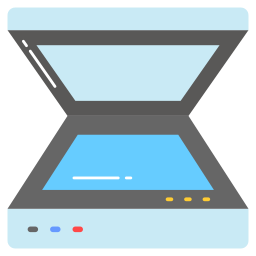
Scanner – External & Peripheral Hardware
A scanner is an external peripheral hardware device designed to convert physical documents, photographs, or objects into digital format. It operates by capturing images through a light sensor, then transmitting the digital copy to a computer or other connected device. Scanners are essential in environments where paper documents need to be stored, edited, or shared electronically. They serve as a bridge between the physical and digital worlds, making them a fundamental tool in offices, educational institutions, creative industries, and home use.
Key Features and Characteristics of a Scanner:
Converts paper-based media into digital files using optical technology
Connects to computers or networks via USB, Wi-Fi, or Ethernet depending on the model
Available in various formats such as flatbed scanners, sheet-fed scanners, handheld scanners, and portable models
Flatbed scanners are ideal for high-resolution scans of photos, books, and delicate documents
Sheet-fed scanners are designed for fast processing of multiple pages, making them suitable for office environments
Handheld and portable scanners offer convenience for scanning on the go or in small workspaces
Supports different file output formats including PDF, JPEG, PNG, and TIFF
Most modern scanners come with software for editing, organizing, and optimizing scanned documents
Optical Character Recognition (OCR) technology is included in many models, allowing text from printed pages to be converted into editable digital text
Compatible with major operating systems including Windows and macOS
Common Applications of Scanners:
Digitizing paper documents for storage, email, or electronic archiving
Scanning photographs for digital preservation or editing
Converting handwritten notes into digital format for easier organization
Used in legal and financial environments for maintaining digital records of signed documents
Essential in academic and research fields for archiving printed materials and referencing
Employed by designers and artists to digitize sketches or artwork for further development
Used in government and administrative offices for document verification and record-keeping
Helpful in healthcare for storing patient records and prescriptions digitally
Supports remote work environments by enabling document sharing without physical delivery
Often used to scan books, ID cards, and passports in libraries or travel-related services
Cost and Accessibility:
Basic flatbed scanners are widely available and relatively inexpensive for personal or small office use
High-speed or network-enabled scanners used in professional environments are more expensive due to additional features and performance
Portable scanners provide affordable options for mobile scanning needs
Some all-in-one printers include scanning functionality, offering a cost-effective solution for multifunctional tasks
There is no recurring cost for scanning documents unless using premium scanning software or cloud services
Most scanner software included with the hardware provides essential features without additional fees
Comparison with Other Digital Capture Devices:
Compared to smartphone cameras, scanners provide significantly higher image accuracy and consistent lighting for documents
While mobile scanning apps are convenient, hardware scanners offer better precision, especially for OCR and color fidelity
Scanners are more effective for scanning bound materials like books or high-resolution photo prints compared to handheld devices
Unlike multifunction printers, dedicated scanners usually offer higher resolution and faster scanning capabilities
For volume scanning tasks, sheet-fed scanners outperform manual scanning methods in terms of speed and efficiency
Conclusion:
Scanners are vital peripheral hardware devices that play an important role in transforming physical documents into usable digital content. Their ability to accurately capture, convert, and store information makes them essential in a wide range of professional and personal applications. With options ranging from affordable flatbed models to advanced sheet-fed units, scanners cater to different user needs and environments. While digital alternatives like mobile apps are useful for quick tasks, dedicated scanners offer superior quality and functionality for consistent and professional results. As the demand for digital workflows continues to grow, scanners remain a crucial component of modern document management systems.












